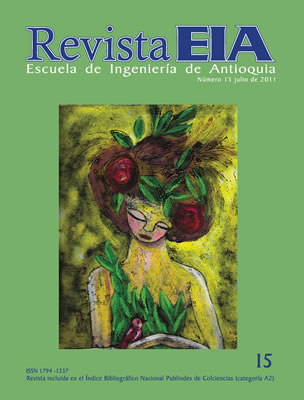EFECTO DE LA DENSIDAD DE CORRIENTE SOBRE LA MORFOLOGÍA Y LAS PROPIEDADES ELECTROQUÍMICAS EN PELÍCULAS ANÓDICAS POROSAS, CRECIDAS SOBRE AA 2024-T3 (EFFECT OF CURRENT DENSITY ON MORPHOLOGY AND ELECTROCHEMICAL PROPERTIES IN POROUS ANODIC FILMS GROwN ON 2
EFECTO DE LA DENSIDAD DE CORRIENTE SOBRE LA MORFOLOGÍA Y LAS PROPIEDADES ELECTROQUÍMICAS EN PELÍCULAS ANÓDICAS POROSAS, CRECIDAS SOBRE AA 2024-T3 (EFFECT OF CURRENT DENSITY ON MORPHOLOGY AND ELECTROCHEMICAL PROPERTIES IN POROUS ANODIC FILMS GROwN ON 2


This work is licensed under a Creative Commons Attribution-NonCommercial-NoDerivatives 4.0 International License.
Copyright statement
The authors exclusively assign to the Universidad EIA, with the power to assign to third parties, all the exploitation rights that derive from the works that are accepted for publication in the Revista EIA, as well as in any product derived from it and, in in particular, those of reproduction, distribution, public communication (including interactive making available) and transformation (including adaptation, modification and, where appropriate, translation), for all types of exploitation (by way of example and not limitation : in paper, electronic, online, computer or audiovisual format, as well as in any other format, even for promotional or advertising purposes and / or for the production of derivative products), for a worldwide territorial scope and for the entire duration of the rights provided for in the current published text of the Intellectual Property Law. This assignment will be made by the authors without the right to any type of remuneration or compensation.
Consequently, the author may not publish or disseminate the works that are selected for publication in the Revista EIA, neither totally nor partially, nor authorize their publication to third parties, without the prior express authorization, requested and granted in writing, from the Univeridad EIA.
Show authors biography
En este artículo se presenta el estudio de las propiedades electroquímicas de las películas anódicas porosas, crecidas sobre la aleación de aluminio AA 2024-T3, obtenidas con la técnica de corriente directa (DC) con densidades de corriente de 10, 15 y 20 mA/cm2 en una solución de H2SO4. El análisis morfológico se realizó con microscopia de fuerza atómica (AFM) y permitió identificar que el aumento en la densidad de corriente genera mayor homogeneidad de la superficie y disminución en los valores de rugosidad. Con la medida de microdureza Vickers, se determinó que los anodizados mejoran su resistencia mecánica frente al sustrato. Para evaluar la resistencia a la corrosión se utilizaron la técnica de espectroscopia de impedancia electroquímica (EIS) y las curvas de polarización Tafel. A partir de estas técnicas se determinó que el aumento en la densidad de corriente forma películas que incrementan la resistencia a la corrosión. Adicionalmente se modeló el comportamiento electroquímico de las películas producidas y se hizo la correlación con las imágenes obtenidas por microscopia electrónica de barrido (SEM).
Abstract: This paper reports the results of a study about the corrosion electrochemical properties of the porous anodic films grown on aluminium alloys 2024 T3, obtained by DC technique at current densities of 10, 15 and 20 mA/cm2 in an aqueous solution of H2SO4. Materials characterization was carried out using atomic force microscopy (AFM) allowing identify that the increase in the current density produces a greater surface homogeneity and a decrease of average surface roughness. The micro-hardness Vickers measurements determined that the hard anodization layer improves their mechanical resistance related to the substrate. To evaluate the corrosion resistance of the anodic films, the EIS technique and Tafel polarization curves were employed. From these techniques it has been determined that the increase in the current density values forms films that increase the corrosion resistance. In addition the electrochemical behavior of the obtained films was modeled and the correlation with the images obtained by scattering electron microscopy (SEM) was made.
Article visits 231 | PDF visits
